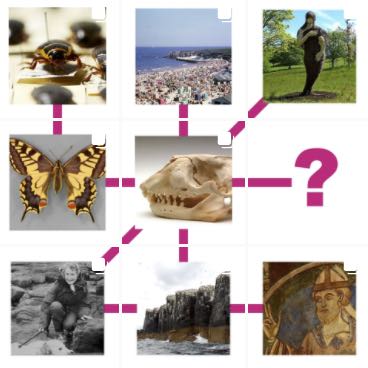Take Part
Help design cutting-edge technology apps
- Are you 16-25?
- Interested in discussing global issues on social media using objects, images and sounds to make your point?
- Interested in exploring how technology like artificial intelligence and chatbots can help?
Work with researchers at Newcastle University and the Great North Museum: Hancock to design new social media apps and an interactive museum exhibit for understanding and discussing global issues like climate action.
Email simon.bowen@newcastle.ac.uk if you’d like to take part.

More Information
We came up with Story:Web - an idea for how museum collections, images and sounds shared online, and people’s experiences could be connected to make sense of climate action and other issues. We built a demo of Story:Web showing how it might work with some example objects, images and sounds, and exhibited it at COP26, the UN Climate Conference. The idea was developed by a team from the Great North Museum: Hancock in Newcastle, Newcastle and Manchester Universities, and sound artist David de la Haye.
With your help, we are now going to build a working system inspired by Story:Web including a way of using objects, images and sounds on social media and in an interactive exhibit in the Great North Museum: Hancock, powered by technology like artificial intelligence and chatbots.
Is the project just about climate action?
No. Climate action was the topic of the ‘Reimagining Museums for Climate Action’ exhibition that Story:Web was part of. There are other topics like biodiversity loss and social justice that the collections of the Great North Museum: Hancock is relevant to. We will begin with climate action and then explore other topics according to the interests and ideas of everyone taking part.
Who can take part?
We’re looking for people who:
- Are aged 16–25 of any background or experience;
- Are passionate, creative thinkers, problem solvers, team players, curious, enthusiastic and responsible;
- And, for workshops, live within reasonable travelling distance of Newcastle upon Tyne.
We hope this project will be as inclusive of everyone’s interests and backgrounds as possible. This includes, but is not limited to, people who do not visit museums and young people who identify themselves as: LGBTQIA+; from working class backgrounds; neurodivergent; disabled; having a migrant or refugee experience; from African Diaspora; from South, East and South East Asian diaspora; and/or ethnically diverse.
How can I take part?
We will design the social media app and interactive museum exhibit in face-to-face and online workshops. We will also share ideas from workshops online for other people to comment on and add to. You can take part in either or both.
What will happen in the design activities?
Design activities will include sharing how you currently use social media and discuss climate action and other issues, exploring how objects in the Great North Museum: Hancock’s collection relate to these issues, and experimenting with technologies like artificial intelligence and social media chatbots.
You will also contribute ideas for a social media app and interactive museum exhibit, and try out and feedback on prototypes of the app and exhibit as they are developed.
We will do these activities in greater depth in workshops than in the online activities.
When and where will the workshops be?
Workshops will be in early 2022 and last for around two hours.
Workshops are will take place at the Great North Museum: Hancock or at Newcastle University, in central Newcastle and online using Zoom.
We will agree the exact timing and duration of workshops with participants, once we know who will be taking part.
Where will ideas be shared online?
Ideas will be shared and discussed on the social media platforms used most by those taking part.
How will I benefit from taking part?
You will help shape a working system that helps people understand global issues and work out what to do about them. For example, this could mean more people understand and do something about climate change or biodiversity loss. ‘Co-designing’ this system with us could also build your confidence and experience.
Through taking part you will learn more about artificial intelligence and social media chatbots, and their applications. You can also understand more about global issues like climate action and how museum collections connect to them.